Atomic-scale structure and bonding in complex materials
Abstract
Modern functional materials are often complex in nature, either because they consist of a large number of elements or because their bonding characteristics deviate from the simple textbook cases. X-ray absorption spectroscopy is a powerful technique to determine the element-specific local structure and bond strength of such complex materials. The talk introduces the basic concepts of this technique and presents two of our recent studies related to thin film photovoltaics and phase-change materials.
The chalcopyrite semiconductor (Ag,Cu)(In,Ga)(Se,S)2 is used as absorber in thin film solar cells and has achieved record conversion efficiencies, because its material properties can be specifically tailored by adjusting the elemental composition. However, X-ray absorption spectroscopy reveals a striking deviation of the element-specific bond lengths from the long-range crystallographic structure. The associated local atomic displacements affect the band gap energy, as demonstrated by theoretical calculations and valence force field modelling. The results highlight the intrinsic structural inhomogeneity of these semiconductor alloys on the subnanometer scale and its impact on important material properties.
Phase-change materials such as Ge-Sb-Te exhibit some unusual properties and their underlying bonding characteristics are still being debated. Inter-atomic force constants derived from temperature-dependent X-ray absorption spectroscopy for elemental Sb are compared with theoretical calculations and with force constants of other elements and compounds, including metals, semiconductors and phase-change materials. The results demonstrate a clear correlation between force constant behavior and nature of bonding. Furthermore, they indicate a continuous transition from localized covalent bonding to delocalized multicenter bonding in phase-change materials, which is directly related to their local structure.
About the speaker
Claudia S. Schnohr received her PhD in Physics from the Australian National University Canberra in 2009. She then worked for several years as an independent researcher at the Friedrich Schiller University Jena. Since 2019 she is full professor and Chair for Experimental Solid State Physics at Leipzig University. Her main research topic are structure-property-relations in complex functional materials, for example semiconductors used in high efficiency thin film solar cells or transparent electronics. In particular, she studies the element-specific local structure on the subnanometer scale using synchrotron and laboratory based X-ray absorption spectroscopy. Combining the results with theoretical calculations and other experimental techniques provides unique insight into the correlations between composition, structure and properties of these complex materials.
This year we will continue with the new format:
- Onsite at Campus Belval, where you will have the opportunity to meet the speaker over the lunch. Catering is offered from 12.00 to all registered participants (MSA 3rd floor). Talk at 13.00 in MSA 3.540
- Online – through Webex – to give you the opportunity to listen to the talk in case you are travelling or cannot make it onsite at Campus Limpertsberg. Here are the details to join the talk online:
For organisational reasons, please register for the lunch before 13 March 2025
